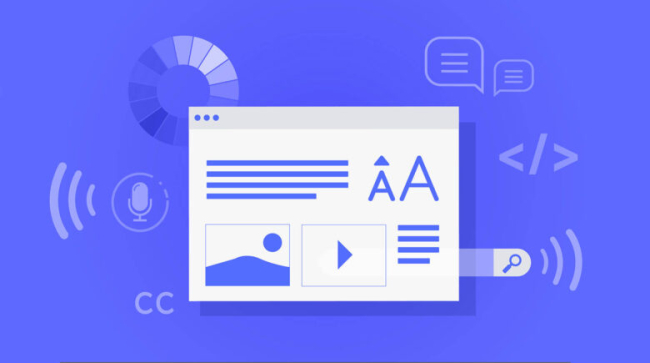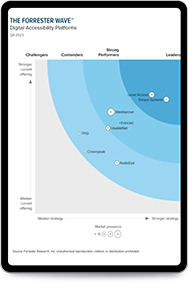Social Media Accessibility Best Practices & Toolkit
Jan 9, 2023
by guest blogger Debra Ruh Ruh Global Consulting

I am a big fan of social media. I use it to highlight the value of including everyone in society, with a special emphasis on the community of people with disabilities (PwD and accessible Internet, Communications, and Technology (ICT). I believe that we (the community of PwD) are finding our voices via social media; however, there are some significant social media accessibility issues that should be addressed.
Blogs, podcasts, social networks, and other social media platforms are increasingly becoming the communication medium of choice, allowing users to communicate, receive information, distribute content and follow updates within and outside of our networks with ease. Unfortunately, most social media applications today do not adequately address accessibility and are difficult to use with assistive technology, which makes them inaccessible to many users with disabilities. Consider that one out of every three households in the U.S. is impacted by disabilities, and according to the World Health Organization one in seven people are impacted by a disability worldwide. Do we really want to exclude as much as 15% of the population from social media? This group of over 1 billion people is a key influencer of the public’s perceptions, and while social media can bring the world to those who can use it, there are still many who cannot.
As an example, WebAIM’s May 2012 screen reader survey indicated that only 54.2% of screen reader users surveyed found social media sites to be “very accessible” or “somewhat accessible”, while 33.7% of respondents said social media sites were “very inaccessible” or “somewhat inaccessible”. There’s certainly a lot of room for improvement there.
Some common accessibility issues with sites like Twitter, Facebook, LinkedIn and YouTube include:
- Lack of section headings
- Poor color contrast
- Inability to navigate using keyboard only
- Inability to operate functionality using keyboard only
- Missing text equivalents for images
- Inability to resize text
- Videos lacking captioning
Social media is part of electronic and information technology; thus, government agencies must comply with Section 508 accessibility when using any of these web-based tools. In addition, non-governmental organizations using social media may have more responsibility to ensure accessible content in the future, as the Department of Justice may issue regulations for websites under Titles II and III of the Americans with Disabilities Act (ADA).
Social Media Accessibility Best Practices
1. Create a Social Media Accessibility Policy
The use of social media websites is becoming an important part of the workplace. These communication tools have the potential to create a significant impact on organizational and professional reputations. It is important for organizations to develop a social media accessibility policy to properly portray, promote and protect the institution, and it is critical to blend accessibility into that policy.
The General Services Administration’s (GSA) Social Media Policy is an example of a policy statement that includes the requirement for social media accessibility. Under item 5, Guiding Principles, GSA lists the following:
“Ensure use complies with applicable mandates, such as Section 508 of the Rehabilitation Act of 1973, IT Security Policy, and the Federal Records Act. The GSA Handbook on Social Media provides greater detail on applicable mandates.”
Including accessibility could also be as simple as adding a statement to your Social Media Policy such as,
“All [organization name]-managed social media sites should meet the organization’s Web Accessibility Policy”,
then providing a link to your Web Accessibility Policy. (You do have a Web Accessibility Policy, right?)
2. Make Your Content Accessible
Here are a few tips for making the content you put out via social media more accessible:
- Provide additional ways to contact your organization such as an 800 number, a Contact Us form or a general contact e-mail address for more information.
- Always put your main content first and put hashtags and @mentions at the end of a post — this is particularly important for screen reader users.
- Photos, Videos and Audio
- If a tweet contains an image, video or audio indicate this at the beginning of the content using the prefix [PIC], [VIDEO] or [AUDIO].
- In addition, if a tweet or Facebook post includes one of these items, be sure to link back to the web page that contains the image, video or audio with a full caption/transcript.
- Avoid the use of acronyms, abbreviations and text messaging shortcuts.
- If you are linking to a PDF document, make sure the document is tagged properly and accessible. If it is not, also provide a link to a text alternative.
- For blogs, ensure proper HTML markup is used such as headings, paragraphs and lists to help orient users and ensure clarity of the content.
Social Media Accessibility Toolkit
There are some great tools available to make social media more accessible to users with disabilities:
- EasyChirp is an alternative to Twitter designed with accessibility and assistive technology in mind.
- Twitter provides a long list of keyboard shortcuts for keyboard only users.
- Facebook also provides a small set of keyboard shortcuts.
- AppleVis, a website created to collect information on the accessibility of apps developed for iOS devices, includes a free, accessible LinkedIn app.
- Easy YouTube caption creator is a content creating tool that generates a standard format caption text file which can be attached to YouTube videos.
- Google offers an accessibility app for the Hangout feature on Google+.
- WordPress, a popular open source blogging tool with many free plugins, allows you to host a page on your own server, giving you more freedom to customize the software for accessibility.
Subscribe for updates

